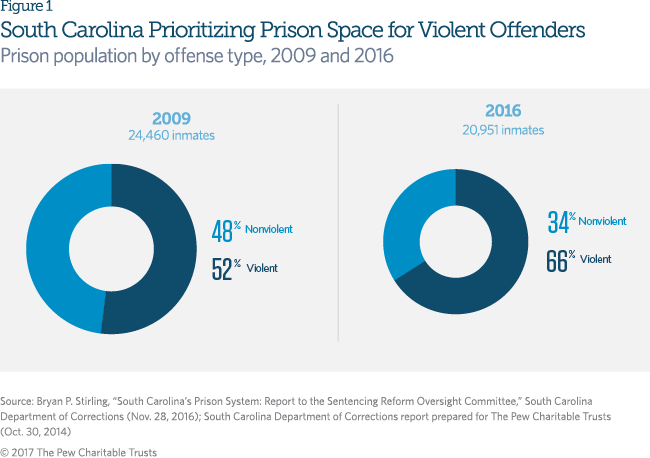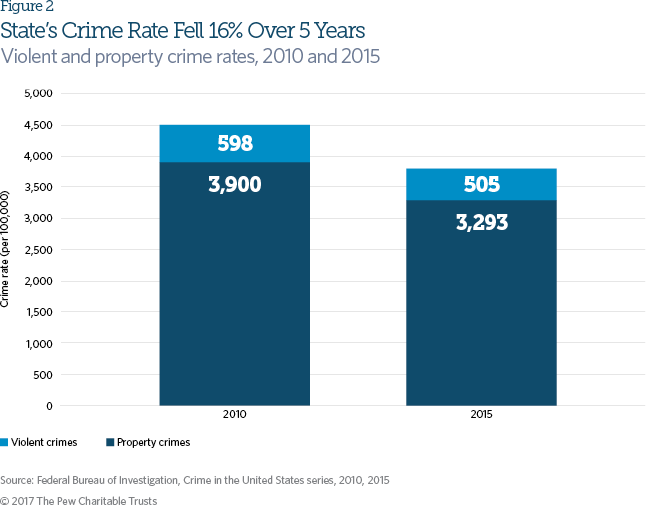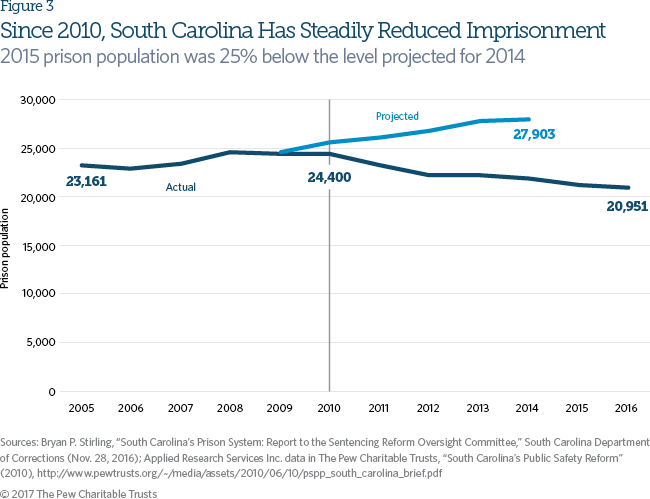Data Trends: South Carolina Criminal Justice Reform
Six years after legislation, the state’s prison population had declined 14%
Sentencing and corrections reforms, passed by a substantial legislative majority in 2010, are having a significant impact on the South Carolina criminal justice system. The reforms reduced penalties for less serious drug and property offenses, expanded release options, strengthened community supervision, and established legislative oversight and accountability. Six years later, six prisons had closed, $491 million had been saved, and the crime rate continued to fall.1
Prison population reduced
- From 2009 to 2016, the prison population declined 14 percent.2
-
The state’s imprisonment rate fell 16 percent, dropping from 11th-highest in the nation to 19th.3
- During the same period, the share of prison space prioritized for violent offenders increased 27 percent.4

Public safety improved
- Between 2010 and 2015, the state’s crime rate fell 16 percent.5
- Revocations to prison for violation of probation or parole rules (not new crimes) declined 33 percent over the same period.6
- The three-year recidivism rate fell 13 percent among those released in 2013 compared with those released in 2009.7

Taxpayer dollars saved
- The prison population fell 25 percent below the level projected for 2014.8
-
South Carolina closed six facilities and avoided adding new prison space.9
- The state saved $491 million through averted spending and reduced operating costs.10

Background
In 2009, South Carolina’s prison population stood at 24,460 inmates and was projected to reach almost 28,000 by 2014. The Legislature charged the Sentencing Reform Commission, a bipartisan group of state officials, with examining the state’s sentencing and corrections policies and recommending changes that would enhance public safety, reduce recidivism, and control corrections costs. After an intensive, nearly yearlong review that involved technical assistance from The Pew Charitable Trusts and other partners, the commission proposed a series of reforms that became the basis of S.B. 1154, the Omnibus Crime Reduction and Sentencing Reform Act. Enacted in 2010, the legislation made South Carolina a national leader in the use of evidence-based policies to deliver a better public safety return on taxpayer dollars. The Sentencing Reform Oversight Committee, formed after the law’s passage, is responsible for monitoring the performance of the reforms. Encouraged by the success of these measures, the state decided in 2017 to pursue further opportunities to improve its criminal justice system.
Endnotes
- South Carolina Department of Corrections report prepared for The Pew Charitable Trusts (Oct. 30, 2014); The Pew Charitable Trusts, “National Imprisonment and Crime Rates Continue to Fall” (December 2016), http://www.pewtrusts.org/en/research-and-analysis/fact-sheets/2016/12/national-imprisonment-and-crime-rates-continue-to-fall. Studies show that crime and imprisonment are not consistently correlated. “National, state, and local crime rates shift for complex and poorly understood reasons, but experts believe that the long-term decline [in the national crime rate] is the result of a combination of factors, including more effective policing, the waning of the crack cocaine epidemic, the spread of car theft-prevention devices and other anticrime technologies, reduced use of cash in favor of electronic payments, and increased incarceration of high-risk offenders.”
-
Bryan P. Stirling, “South Carolina’s Prison System: Report to the Sentencing Reform Oversight Committee,” South Carolina Department of Corrections (Nov. 28, 2016); South Carolina Department of Corrections report prepared for The Pew Charitable Trusts (Oct. 30, 2014).
-
Ann Carson and Joseph Mulako-Wangota, “Imprisonment Rates of Jurisdiction Population—Sentences Greater Than 1 Year,” Bureau of Justice Statistics (Nov. 16, 2016), https://www.bjs.gov/index.cfm?ty=nps. Data were generated using the Corrections Statistical Analysis Tool (CSAT)—Prisoners.
-
Bryan P. Stirling, “South Carolina’s Prison System: Report to the Sentencing Reform Oversight Committee”; South Carolina Department of Corrections report prepared for The Pew Charitable Trusts (Oct. 30, 2014).
-
FBI Uniform Crime Reports. See “Crime in the United States, 2010: Table 5,” https://ucr.fbi.gov/crime-in-the-u.s/2010/crime-in-the-u.s.-2010/tables/10tbl05.xls;and “Crime in the United States, 2015: Table 5,” https://ucr.fbi.gov/crime-in-the-u.s/2015/crime-in-the-u.s.-2015/tables/table-5.
-
South Carolina Department of Probation, Parole, and Pardon Services, “Report to the Sentencing Reform Oversight Committee” (November 2016), https://www.dppps.sc.gov/content/download/109254/2495311/file/SROC+Report+11.18.16+Final.pdf.
-
South Carolina Department of Corrections, “Recidivism Rates of Inmates Released during FY2009-FY2013,” http://www.doc.sc.gov/research/SpecialReports/RecidivismRatesOfInmatesReleasedDuringFY2009-FY2013.pdf.
-
Bryan P. Stirling, “South Carolina’s Prison System”; Applied Research Services Inc. data in The Pew Charitable Trusts, “South Carolina’s Public Safety Reform” (2010), http://www.pewtrusts.org/~/media/assets/2010/06/10/pspp_south_carolina_brief.pdf.
-
South Carolina Sentencing Reform Oversight Committee, “State Expenditures Savings Report” (December 2016) http://www. scstatehouse.gov/citizensinterestpage/SentencingReformOversightCommittee/Reports/2015SROCStateExpendituresSavingsReport.pdf.
- The Pew Charitable Trusts’ analysis, presented to the South Carolina Sentencing Reform Oversight Committee in November 2016.











